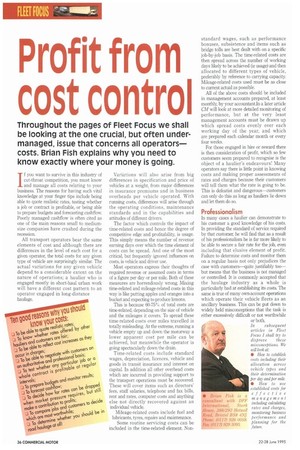Profit from cost control
Page 38

If you've noticed an error in this article please click here to report it so we can fix it.
Throughout the pages of Fleet Focus we shall be looking at the one crucial, but often undermanaged, issue that concerns all operators costs. Brian Fish explains why you need to know exactly where your money is going.
If you want to survive in this industry of cut-throat competition, you must know and manage all costs relating to your business. The reasons for having such vital knowledge at your finger tips include being able to quote realistic rates, testing whether a job or contract is profitable, or being able to prepare budgets and forecasting cashflow. Poorly managed cashflow is often cited as one of the main reasons small to mediumsize companies have crashed during the recession.
All transport operators bear the same elements of cost and although there are differences in the level of each cost for a given operator, the total costs for any given type of vehicle are surprisingly similar. The actual variations for any given vehicle depend to a considerable extent on the nature of operations; a haulier who is engaged mostly in short-haul urban work will have a different cost pattern to an operator engaged in long-distance
haulage. Variations will also arise from big differences in specification and price of vehicles at a weight, from major differences in insurance premiums and in business overheads per vehicle operated. With running costs, differences will arise through the operating conditions, maintenance standards and in the capabilities and attitudes of different drivers.
The factor which controls the impact of time-related costs and hence the degree of competitive edge and profitability, is usage. This simply means the number of revenue earning days over which the time element of costs can be spread. And one of the most critical, but frequently ignored influences on costs, is vehicle and driver use.
Most operators express their thoughts of required revenue or assumed costs in terms of a figure per day or per mile. Both of these measures are horrendously wrong. Mixing time-related and mileage-related costs in this way is like putting apples and oranges into a bucket and expecting to produce lemons.
This is because 60-75% of total costs are time-related, depending on the size of vehicle and the mileages it covers. To spread these time-related costs over miles travelled is totally misleading. At the extreme, running a vehicle empty up and down the motorway a lower apparent cost per mile can be achieved, but meanwhile the operator is going spectacularly down the drain.
Time-related costs include standard wages, depreciation, licences, vehicle and goods in transit insurance and interest on capital. In addition all other overhead costs which are incurred in providing support to the transport operations must be recovered. These will cover items such as directors' fees, staff salaries, telephone and fax bills, rent and rates, computer costs and anything else not directly recovered against an individual vehicle.
Mileage-related costs include fuel and lubricants, tyres, repairs and maintenance. Some routine servicing costs can be included in the time-related element. Non standard wages, such as performance bonuses, subsistence and items such as bridge tolls are best dealt with on a specific job-by-job basis. The time-related costs are then spread across the number of working days likely to be achieved fie usage) and then allocated to different types of vehicle, preferably by reference to carrying capacity. Mileage-related costs used must be as close to current actual as possible.
All of the above costs should be included in management accounts prepared, at least monthly, by your accountant.In a later article CM will look at more detailed monitoring of performance, but at the very least management accounts must be drawn up which spread costs evenly over each working day of the year, and which are prepared each calendar month or every four weeks.
For those engaged in hire or reward there is then consideration of profit, which so few customers seem prepared to recognise is the object of a haulier's endeavours! Many operators say there is little point in knowing costs and making proper assessments of rates and charges because their customers will tell them what the rate is going to be. This is defeatist and dangerous—customers can only do this as long as hauliers lie down and let them do so
Professionalism
In many cases a haulier can demonstrate to his customer a good knowledge of his costs. In providing the standard of service required by that customer, he will find that as a result of his professionalism he is far more likely to be able to secure a fair rate for the job, even including that elusive element of profit. Failure to determine costs and monitor them on a regular basis not only prejudices the case with customers—quite justifiably too— but means that the business is not managed or controlled. It is commonly accepted that the haulage industry as a whole is particularly bad at establishing its costs The same is true of many own-account operations which operate their vehicle fleets as an ancillary business. This can be put down to widely held misconceptions that the task is either excessively difficult or not worthwhile or both.
In subsequent articles in Fleet Focus I shall try to disprove these misconceptions. We will look at: • How to establish costs including their allocation across vehicle types and their determination per day and per mile • How to use established costs for e ffective management including cakulating rates and charges, monitoring business performance and planning for the future




































































































